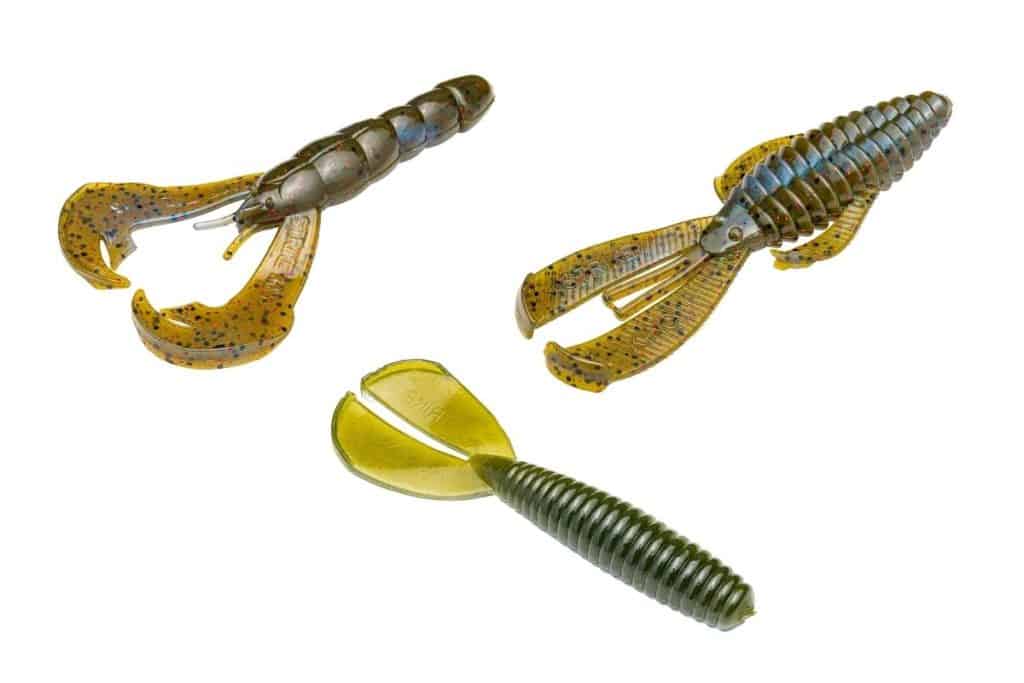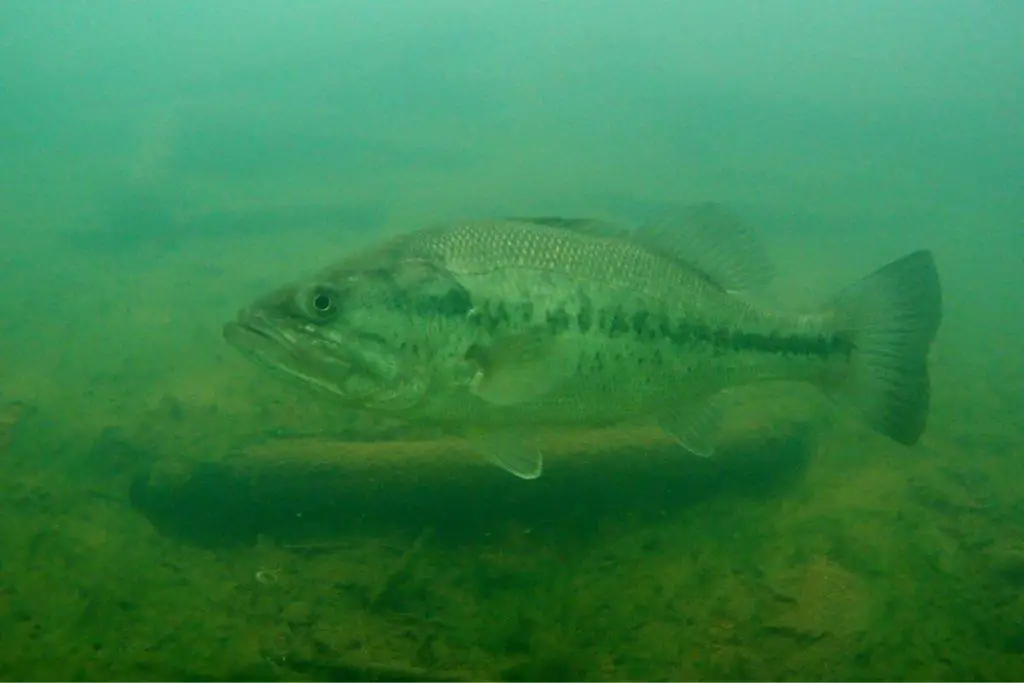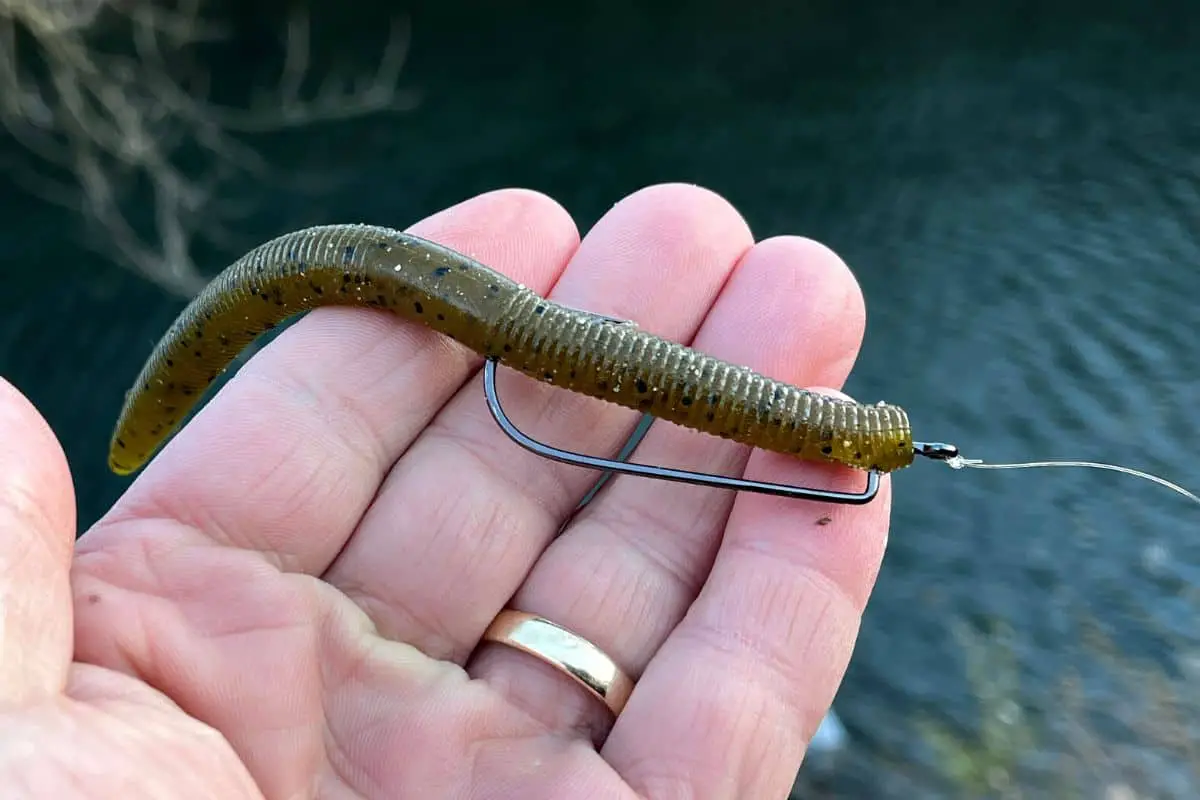A Texas rig may be the most versatile and widely used presentation in bass fishing. It can be fished 365 days a year in any conditions, but there are key situations where it is a top choice.
A Texas rig excels in thick cover. It is also one of the few rigs that can cover the entire column when using one lure.
Let’s cover some of the best situations for Texas rigs and why anglers should always have one ready.
What the Term Texas Rig Means
This term, Texas rig, is often misunderstood. When most bass anglers hear these words being used they envision a worm weight slipped up the line, a hook then tied on, and then rigging the soft plastic weedless. This is all correct.
But, we often forget the weight has nothing to do with the term Texas rig. This popular bass fishing rigging method is all about the hook and it being embedded in the plastic to make it weedless. A Texas rig can be used with or without a weight.
When we take this important factor into consideration it opens this presentation up to a much broader range of applications.
(Here is an article that goes into detail about using a Texas Rig.)
Texas Rigs and Thick Cover
Using soft plastics around cover like weeds and wood is exactly why this method was first developed early in the last century.
Bass love to swim around the edges of cover and chase down prey that hides there. A Texas-rigged soft plastic makes for an efficient presentation that slips through the gnarliest of places.
There are a lot of anglers that will opt for a jig when fishing wood over a Texas rig, but it is more a matter of personal preference. The thought behind this is that many anglers believe the worm weight will fall over a branch and leave the plastic hanging on the other side and not follow it over the limb.
This is simply not true.
I have tested this underwater and filmed a Texas rig in wood for hours. Not one time did the worm weight come over the limb and leave the plastic dangling on the other side.
The video going over this experiment is linked below.
The one time when there is separation between the lure and weight causing problems is when punching thick matted vegetation with a Texas rig.
Sometimes, the weight falls through and leaves the soft plastic sitting on top of the weeds. Pegging the worm weight will keep the two together and let anglers punch the plastic right through some very thick cover.
Bass fishing is all about efficiency – how long during the presentation is our lure free of debris and actually effective? A Texas rig in thick cover is effective and working for us most of the time.

Texas Rigs Effectively Search the Entire Water Column
This may be what separates a Texas rig from other presentations the most.
A Texas-rigged soft plastic can effectively and efficiently cover the entire water column. And for many soft plastics, this can be done with one lure.
The bait is powerful on the drop, when sitting on the bottom, and then anglers can swim a lure all the way back to them. This is such an important aspect of Texas rigs to take advantage of. Bass reposition themselves based on the conditions and until we get them dialed in, searching all parts of the water column is important.
There are some soft plastic lures that are more effective than others for this three-part retrieve, but essentially any of them will get the job done.

When I want a lure to work on the drop, on the bottom, and swimming back to me, I will most often choose a plastic that has a tail or appendage that provides swimming action. This could be something as simple as a twin-tail grub, craw, or a swimming worm like a ribbontail.
The traditional soft plastic worm on a Texas rig consistently wins a lot of money on the major tournament trails each year. A big reason for this is its effectiveness throughout the water column.
Texas Rigs and Searching for Bass
Each time we hit the water we must first find the bass.
I like to break this approach down with this phrase, “search, search, search and then catch.”
Searching lures cover water in a more horizontal retrieval pattern and get the bass to reveal themselves. This could be by actually catching a fish, but it also can be when a bass follows the lure or takes a swipe at it without getting hooked up.
The result is the same. The lure searched and found where bass are currently located.
Why is this so important? One of the biggest mistakes anglers make is catching a bass and moving on. After almost three years and hundreds of hours of filming bass underwater, I can say with confidence that bass are rarely alone.

The conditions that are favorable for holding one bass are going to hold multiple fish.
That searching lure that provoked a bass to reveal itself could have just shown you where a pile of others are sitting.
There are a few Texas-rigged soft plastics that stand out for searching lures. It is important to remember that while searching we are most likely swimming that lure back to us.
My favorites are soft jerkbaits, swimbaits, and swimming a worm.
The soft jerkbait is my favorite and I will use both a fleeing baitfish retrieve where the lure skips across the surface and then the more traditional twitch-pause method and let the bait sink.
The swimbait and swimming worm are great brought back on a slow steady retrieve but throwing some erratic start-and-stops in there will often get the bass to react.
Remember, the goal is to locate bass, and catching them is a bonus. Once you find the bass with a Texas rig then you can alter presentations and lures to adapt to what is going on. The bulk of the fish may be caught crawling the worm on the bottom once you get the single bass to reveal where they are hiding.

Texas Rigs and Tough Conditions
I wish that bass fishing was always easy. That’s just not the case. Most often the conditions are tough or when we have a chance to actually go, the situations are not ideal. Such is life.
That is why Texas rigs should always be ready when conditions are challenging.
There are so many soft plastic lures that are natural looking in both shape and coloration. When bass are finicky this is often the difference between bites and no action.
I have been shocked when filming bass underwater how many times our favorite game fish will come and investigate the lure, watch it for a few seconds, and then swim off.
Bass are curious creatures. When the conditions are challenging and that bass is looking at the lure closely, it needs to resemble something they are interested in. Too much movement most often repels the fish when they are in a foul mood. Soft plastic Texas rigs look real and are extremely effective when sitting motionless.
Whether you are a shore angler or fish from a boat, a Texas-rigged soft plastic should always be ready.
Good luck out there and make sure to encourage someone today. You never know how you may change their life forever.
Isaiah 6:8

